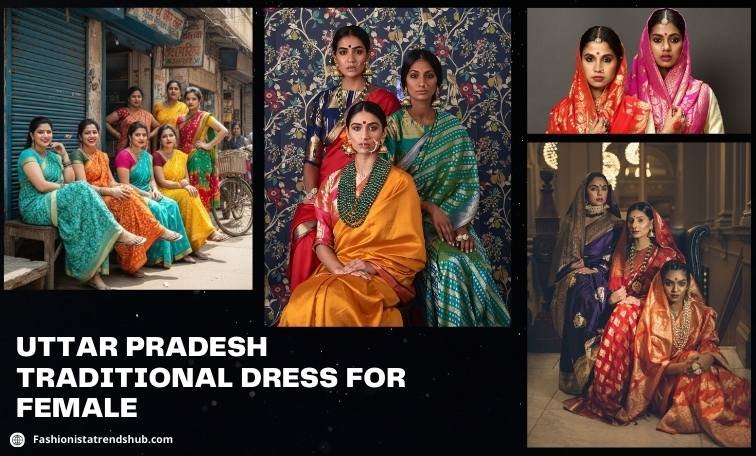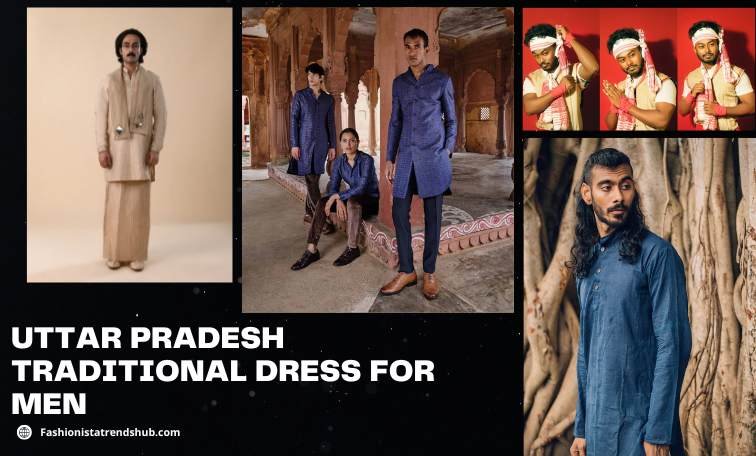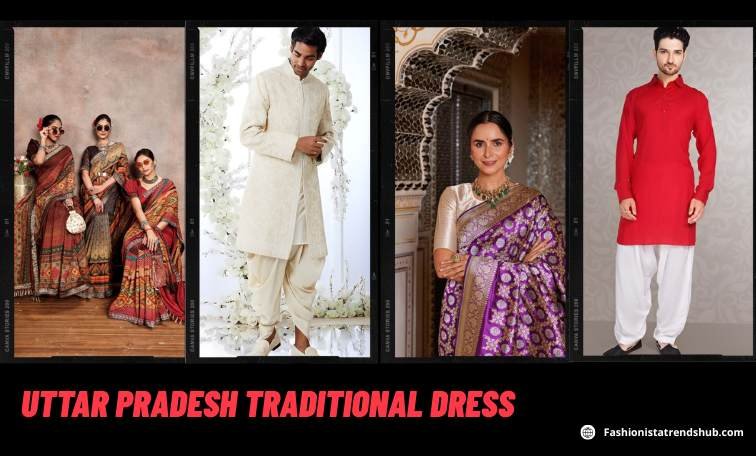When one thinks of Uttar Pradesh traditional dress, images of bright silks, intricate embroidery work, flowing fabrics, and ancient threads come to mind. This clothing doesn’t just cover bodies; it interlaces them with stories, regional loyalties, religious identities, and familial pride. Throughout villages and palaces, this traditional dress of Uttar Pradesh still dominates ceremonies, daily life, and cultural fests. In this post, we will talk about everything that you need to know about the traditional wear of India’s Heartland.
Significance of Uttar Pradesh Traditional Dress
Traditional dresses don’t just live on — they adapt. Here’s why Uttar Pradesh traditional dress still matters, and how it continues to evolve:
- Emotional & Cultural Anchor: These outfits hold memories like wedding sarees passed down, bridal lehengas hand-embroidered by grandmother, or kurta sets from childhood. They shape identity.
- Artisan Livelihoods: Many of the rural communities rely on weaving, embroidery, and craft work. They earn money thanks to the demand for the traditional attire of Uttar Pradesh.
- Fashion Adaptation: Designers are remolding traditional silhouettes (like a Chikankari short dress or a saree gown), which resonate with the younger audience.
- Fusion Trends: Mix-and-match—such as a plain kurta with a Banarasi border dupatta, Kalamkari prints on chikankari or brocade jackets over salwar kameez—is in vogue.
- Accessibility: Machine-embroidered renditions, printed motifs, and pre-draped styles render classic varieties less expensive and easier to wear on a daily basis.
Top 5 Must-Try Uttar Pradesh Traditional Dress
Here are five standout ensembles worth exploring in Uttar Pradesh traditional dress haul:
- Banarasi Silk Saree with Zari Motifs
- Chikankari Kurta / Saree / Dupatta Set
- Mukaish Lehenga Choli with Soft Metallic Dots
- Farshi Pajama for Royal Occasions
- Ethnic Salwar‑Kameez with Embroidered Borders
Every style is customizable — lace, color, and motif can all be tailored to personal preference and contemporary sensibility.
Uttar Pradesh Traditional Dress Female

Women’s traditional wear in Uttar Pradesh is indicative of the rich diversity as well as the labour-intensive craftsmanship attached to each costume across its regions.
- The focus is on the saree, whether it’s the opulent silk Banarasi sarees with zari and brocade in Varanasi or the light Chikankari embroidered options of Lucknow. Sarees are worn in Nivi style, combined with embroidered matching or contrasting blouses.
- The salwar kameez is popular both for casual and formal wear – more casual varieties are often made in cotton – and they are worn throughout India by women of all ages. Chikankari kurtas, serried with plain bottoms, are a regional signature, while Anarkali and straight cut kurtas come out in festival force.
- As for the wedding and festivals, women have even more options: essentially, there’s Lehenga Choli — a flared skirt with a fitted blouse (choli) and a dupatta, which is often elaborately embroidered with Zardozi-mirror work embroidery, along with other traditional patterns. Designs such as the Mukaish Lehenga or Farshi Pajama bring an aristocratic grace, while local elements such as Phool Patti appliqué keep it traditional.
These clothes are the cultural symbol of Uttar Pradesh, and they seem colourful while also exuding the craftsmen’s hard work. The only other things that adorn these rare sights are the women’s ethnic dresses of this area.
Uttar Pradesh Traditional Dress for Male

Uttar Pradesh traditional dress for men comes with less variety; however, it is rich in culture as it is inherited from the regional customs, rituals, and comfort.
- The daily attire of men frequently comprises a kurta-pajama, a long tunic (kurta), and trousers like garment which are called pyjamas.
- The dhoti-kurta is still the most common attire for rural areas: a wrapped dhoti tied to form a pant, with or without a tail, and a matching kurta.
- On formal or festive occasions, men wear a sherwani (long coat-like tunic) or an angarkha (a traditional robe with overlapping front panels) tied at the waist.
- In many communities, a pagri or topi is either a symbol of status. It can represent caste, religion, profession, region, and fashion.
These are usually made with silk, brocade, zari, thread work & contrasting borders. These are also worn as an alternative to a saree and can make you look sleek in them.
Influence of Climate on Uttar Pradesh Traditional Dress
The weather varies as per season; this diversity in climate directly impacts the choice of ethnic clothing. This state’s landmass experiences scorching heat during summer and extreme cold during winter. With a climate that experiences extremes of both, call for outfits that are appropriate for the weather.
When the hot months are on, people prefer lightweight fabrics. Uttar Pradesh traditional dress, like dhoti-kurta, lungi, and Chikankari sarees, are made from cotton and muslin (these fabrics are extremely breathable).
In the winter season, fabrics that provide warmth are used. Fabrics to the likes as silk and velvet are used in sherwanis, lehngas, and banarasi sarees.
Seasonal adaptability is vital for some garments, for example, Angarakha is made from warmth-providing fabrics in winter, and with light fabrics in summer.
Overall, these traditional attires showcase skilled craftsmanship. The versatility of these garments offers year-round comfort while preserving cultural elegance. These clothes are a testament to the ideal balance between practicality and style.
Embroidery Behind the Costume Uttar Pradesh Traditional Dress
The uniqueness of Uttar Pradesh traditional dress lies heavily in the textile techniques and embellishments. Here are several key crafts that define the state’s costume identity:
| Craft / Technique | Region / Center | Signature Element | Used On / Garment Types |
| Chikankari | Lucknow | White thread on light fabrics, shadow stitch, jaali | Sarees, kurtas, dupattas |
| Zardozi | Lucknow, Lucknow sterility | Metallic threads, beads, pearls | Bridal lehengas, sherwanis |
| Phool Patti / Appliqué | Aligarh, Rampur | Floral motifs cut from fabric and appliquéd | Sarees, lehengas, dupattas |
| Brocade & Brocade Weave | Varanasi (Banarasi) | Gold/silver zari in warp/weft | Sarees, borders of lehengas |
These embellishments are what lift a garment from being simply a “traditional dress of Uttar Pradesh” to a wearable artwork. Artisans often weave motifs inspired by nature (lotus, foliage, animals) or geometric patterns drawn from Mughal and Awadhi influence.
Regional Variants of Uttar Pradesh Traditional Dress
Uttar Pradesh is not monolithic. Its enormous size and varied culture result in subtle—but intriguing—regional variations of dress:
- Awadh / Lucknow belt: Insight in light hues, delicate Chikankari, pastels, and ensembles that drape exude an airy feel.
- Eastern UP: Richer fabrics, heavier gold thread work, and higher usage of bright colours.
- Western UP: In villages, basic dye works or bandhani scarves, or mirror work are woven into the universe of salwar-kameez.
- Rural belt/villages: Functionality reigns—cotton suits, block prints, less embroidery, long skirts with blouses or a simple style wrap.
Thus, while the traditional dress of Uttar Pradesh has recognizable themes, even though it varies as per climatic, occupational, and regional aesthetic variations in the state.
Uttar Pradesh & Rajasthan Outfits Comparison
The neighboring states have a lot in common, for obvious reasons. Let’s talk about some similarities in ethnic wear that they share when it comes to their ethnic dresses:
| Aspects | Uttar Pradesh Traditional Dress | Rajasthani Traditional Dress | Similarities |
| Core Women’s Outfit | Saree, Lehenga Choli, Salwar Kameez | Ghagra Choli (Lehenga), Odhni, Saree | Lehenga Choli & Saree for festive and bridal wear |
| Core Men’s Outfit | Kurta-Pajama, Dhoti-Kurta, Sherwani | Kurta-Dhoti, Angrakha, Bandhgala | Kurta & Dhoti are common, especially among the rural masses |
| Use of Dupatta/Odhni | Dupatta with Salwar or Lehenga, often embroidered | Odhni or Dupatta with Lehenga, often dyed | A dupatta/Odhni is worn over the shoulders for modesty and decoration |
| Embroidery Styles | Chikankari, Zardozi & Phool Patti | Gota Patti, Zardozi, Mirror Work | Both use Zardozi for bridal/festive wear |
| Types of Textile & Fabric | Silk (Banarasi), Cotton, Georgette | Cotton Bandhani, Silk (Kota Doria, Leheriya) | Use of natural fabrics suited to the weather |
| Colors & Aesthetics | Deep red, gold, pastel (notably in Chikankari) | Bright red, orange, yellow, green | Vibrant colors symbolize joy and celebration |
| Foot Wear | Mojari (embroidered slippers), Juttis | Mojari, Juttis | Handcrafted leather footwear is used |
| Event | Weddings, religious festivals, cultural programs | Weddings, Teej, Gangaur, Diwali, etc. | Both are linked with festive and ceremonial wear |
| Rural vs. Urban Usage | Traditional styles are still strong in villages; urban areas favor modern fashion | Similarly, rural women stick to traditional clothing; urban women prefer fusion styles | Distinction between rural preservation and urban adaptation |
| Origin Cities of the craft | Lucknow (Chikankari), Varanasi (Silk), Aligarh (Phool Patti) | Jaipur (Block Print), Udaipur, Jodhpur, Kota | Both regions are renowned textile and craft hubs |
How to Choose & Style Uttar Pradesh Traditional Dress
The next time you wear or shop for Uttar Pradesh traditional dress, remember these tips:
Fabric & Season
- Opt for some lightweight cotton or chiffon with little embroidery work in summer.
- For winter or wedding times, you should go for silk, brocade, or a thicker fabric type.
- When picking a Banarasi sari, ensure you’re paying attention to how much zari is in it (the more zari, or pure gold/silver thread that’s used, the pricier and the more differently it drapes).
Embroidery & Craft Quality
- Check the back stitching to ensure cleanliness and ‘puckering’ are both minimized on chikankari.
- Loose beads or threads need to be checked out for the Zardozi work.
- In appliqué (Phool Patti), make sure that the edges are nicely hemmed and reinforced.
Color & Motif
- Pale pastels (pinks, greens, ivories) work for the day.
- Weddings are often swimming in deep reds, maroons, and royal blues.
- Patterns like vines, paisleys, florals, or geometrics may correspond to your region or family background.
Draping & Pairing
- While draping sarees, try different styles (classic Nivi, Gujarati rope, lehenga drape).
- Try a bit of an experiment with dupatta placement. There is a lehenga choli idea, wear a V top and drape the dupatta over your shoulders, around the head, or as a sash. Do not forget the ghagra below
- Throw on modern jewelry (statement earrings, multiple strands draped around your neck) to add a contemporary twist.
Maintenance
- Do not store zari work sarees folded. This can cause the zari to break.
- Use muslin covers or fabric bags.
- Dry clean, especially for delicate embroideries or layered lehengas
Final Thoughts
To style an Uttar Pradesh traditional dress is to put on more than just a cloth made from fabric— it’s to bring history, regional pride, and craftsmanship through time inside out. Whether it’s a bride wrapped in Banarasi silk, a wedding guest wearing a Chikankari kurta, or a groom donning a brocade sherwani, each outfit reflects the efforts of craftsmen who have invested hours into the piece.
If you ever buy online or shop in the lanes of Lucknow or Varanasi, remember that authenticity is in the texture and quality of embroidery, its motif balance, and how your costume feels, not just in looks but also on you.
Also Read More
- The Beauty of Kerala Traditional Dress: Fabrics, Festivals & Styling Tips
- Assam Traditional Dress : For Male, Female, Kids, Styling tips and More
- Andhra Pradesh Traditional Dress: A Colorful Tapestry of Culture
- Rajasthani Traditional Dress: A Colorful Heritage of the Desert State
Refresh Date: September 25, 2025

